the history of yeovil's pubs
PUBS HOME PAGE |
PUBS INTRODUCTION |
PUBS BY NAME |
BEERHOUSES |
pall inn / hotel / taVERN
15 Silver Street
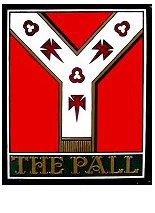 A
pall, or
mortcloth, is a
cloth which
covers a coffin
at funerals and
for many years
the sign of the
Pall Tavern
(marked 'A' on
the 1886 map
below left) was based
on an elaborate
pall owned by
the
Woborn Almshouse
that was hired
out for such
occasions (the
Pall's mortcloth
sign is
illustrated at
left). The Pall
Tavern,
properly, should
be pronounced
The 'Paul'
Tavern.
A
pall, or
mortcloth, is a
cloth which
covers a coffin
at funerals and
for many years
the sign of the
Pall Tavern
(marked 'A' on
the 1886 map
below left) was based
on an elaborate
pall owned by
the
Woborn Almshouse
that was hired
out for such
occasions (the
Pall's mortcloth
sign is
illustrated at
left). The Pall
Tavern,
properly, should
be pronounced
The 'Paul'
Tavern.
William Phelips, who was resident in Preston Plucknett from 1675 until his death in 1714, made a will dated 19 February 1713-14. Besides a monetary gift of £100 to the almshouse "near the Horsepoole in Yeovill" (Woborn’s), he also included the following: "I give to the church of Yeovill a good large pall cloth with large black silk tuffits to be kept by the minister or churchwardens in the church chest and each person that desires to use the same in or out of the said parish shall pay five shillings a time in Preston and in the towne and six shillings out of the towne, which said five or six shillings shall be paid over to the custos of the aforesaid almshouse".
In fact the original Woborn Almshouse, founded in 1477, was sited just behind the property that was to become the inn, the site is occupied now by an Indian restaurant.
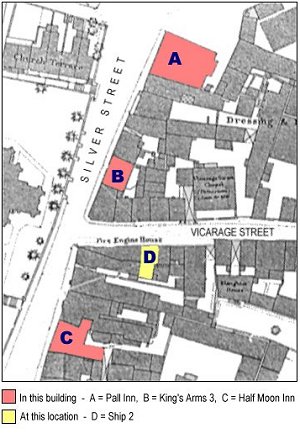 The
Pall Tavern in
Silver Street
(as well as
the
Three
Choughs Hotel
and the
George Inn)
was for
centuries owned
by the Woborn
Almshouse and
the rent of the
building
provided income
for the
Almshouse. The
medieval
almshouse had
become so
ruinous by the
1850’s that the
new Woborn
Almshouse was
built in 1860 at
its present site
on the junction
of
South Street
and
Bond Street.
It is not really
clear when the
Pall Tavern
first opened its
doors - the
current building
only dates from
1836, but its
predecessor had
been trading for
many
generations.
The
Pall Tavern in
Silver Street
(as well as
the
Three
Choughs Hotel
and the
George Inn)
was for
centuries owned
by the Woborn
Almshouse and
the rent of the
building
provided income
for the
Almshouse. The
medieval
almshouse had
become so
ruinous by the
1850’s that the
new Woborn
Almshouse was
built in 1860 at
its present site
on the junction
of
South Street
and
Bond Street.
It is not really
clear when the
Pall Tavern
first opened its
doors - the
current building
only dates from
1836, but its
predecessor had
been trading for
many
generations.
The first record in which the Pall is mentioned as an inn as opposed to a private dwelling, is in a lease dated 1769 - see Documentation below - in which it was claimed to be 'in very ruinous condition'. In 1796, the Woborn Almshouse account book lists Mrs Kitson as paying 16/- rent for the George in Middle Street, another Almshouse property, while she was already renting the Pall. In 1837 a day coach, called the Victoria, left the Pall Tavern three times a week for Salisbury - a journey that took seven hours.
Silver Street at that time was a dirty, dingy and very narrow street with small lean-to cottages built against the churchyard walls opposite and the Pall Tavern itself was several feet closer to the road. At this time there was no sewage system in Yeovil and it is recorded that five-feet deep open ditches, euphemistically called 'sewers', ran alongside most streets, including an open drain that ran from the Pall Tavern to the town gasworks.
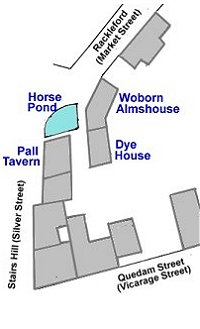 This open sewer
was still extant
in 1849 when a
Government
report commented
that Yeovil was
"a very filthy,
a very dirty and
a very stinking
place". Also
just outside the
Pall Tavern,
where Silver
Street and
Market Street
met, was a pond
called the
Horse Pool
where the town's
ducking stool
had been sited.
The Horse Pool
was fed by a
small stream
called the
Rackle -
hence Rackleford
or Reckleford,
the ford across
the Rackle. In
fact Market
Street, in a
document dated
1355, is
referred to as
Ford Street
although by the
time Pall Tavern
was operating
Market Street
was called
Reckleford (and
colloquially
known as Rotten
Row), while the
modern
Reckleford was
known as
Reckleford Hill
and Lower
Reckleford.
Confusing
enough? The
Horse Pool was
finally covered
in during the
early 1850's -
see
Documentation
below.
This open sewer
was still extant
in 1849 when a
Government
report commented
that Yeovil was
"a very filthy,
a very dirty and
a very stinking
place". Also
just outside the
Pall Tavern,
where Silver
Street and
Market Street
met, was a pond
called the
Horse Pool
where the town's
ducking stool
had been sited.
The Horse Pool
was fed by a
small stream
called the
Rackle -
hence Rackleford
or Reckleford,
the ford across
the Rackle. In
fact Market
Street, in a
document dated
1355, is
referred to as
Ford Street
although by the
time Pall Tavern
was operating
Market Street
was called
Reckleford (and
colloquially
known as Rotten
Row), while the
modern
Reckleford was
known as
Reckleford Hill
and Lower
Reckleford.
Confusing
enough? The
Horse Pool was
finally covered
in during the
early 1850's -
see
Documentation
below.
The Kings Arms Inn, four doors away, had also stood for many years in Silver Street but a major fire in 1835 destroyed it along with several other premises. Following the fire all the premises from the Kings Arms to and including the Pall (shown in the photograph below) were rebuilt further back from the road so that Silver Street could be widened thereby easing congestion in the centre of the town. Looking at the photograph below it makes you wonder how narrow Silver Street must have been before 1835, bearing in mind that at that until about 1816 there were also small houses built up against the church boundary wall at right, seen just beyond the cars at right in the photo below. The Pall was rebuilt in 1836 and the old materials were sold off for £22.10s.
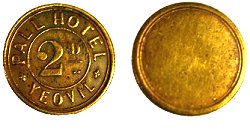 At left is an
undated but
probably late
Victorian public
house 'check' or
trade token
issued at the
Pall Hotel. It
is made of
brass, is 25mm
in diameter and
has a milled
edge. The
reverse is plain
but on the
obverse it says
"PALL HOTEL,
YEOVIL" and its
value - 2D. At
this time two
old pence could
buy you a pint
of stout. Checks
were frequently
used in games,
such as skittles
or quoits where,
for instance,
players would
'chip in' a
check to the
'kitty' which
would be won by
the winning team
to redeem at the
bar. By issuing
checks a
landlord could
guarantee they
would be spent
in his
establishment
only.
At left is an
undated but
probably late
Victorian public
house 'check' or
trade token
issued at the
Pall Hotel. It
is made of
brass, is 25mm
in diameter and
has a milled
edge. The
reverse is plain
but on the
obverse it says
"PALL HOTEL,
YEOVIL" and its
value - 2D. At
this time two
old pence could
buy you a pint
of stout. Checks
were frequently
used in games,
such as skittles
or quoits where,
for instance,
players would
'chip in' a
check to the
'kitty' which
would be won by
the winning team
to redeem at the
bar. By issuing
checks a
landlord could
guarantee they
would be spent
in his
establishment
only.
It is interesting to note that, in its advertising, the Pall offered good stabling, with horses and traps let for hire. In 1879 Thomas Luxton was advertising "A Commodious Tent with all Appliances to be Let on Hire" and by 1899 the Pall was boasting a 'good bowling alley'.
The Ministry of Town & Country Planning's Provisional List of Buildings of Architectural or Historic Interest of July 1948 described the building and its neighbours thus - "Silver Street bounds churchyard on east side. Houses on one side only, facing church. The houses themselves are mostly 18th or early 19th century in date. They are not of great merit individually but they retain their Georgian scale and form part of the pleasant surroundings of St John's church. They are therefore of value in a largely modern town. Grade III. No 15 (Pall Hotel) - Three-storey three-window painted brick front. Tablet on corner is inscribed 'Rebuilt 1836'. Sash windows. Simple late Georgian door case with wire guard above cornice to take flower-box. Wrought-iron bracket carrying sign projects from angle of house."
The following description is taken from the Somerset Historic Environment Record - "Inn, rebuilt in 1856 (sic), possibly using some earlier material. Brick, colourwashed, with double Roman clay tile roof 3-storeys in a plain Georgian style of 3-wide bays. Central 6-panel entrance door with simple stone surround and flat hood, 16-pane sash windows on either side in plain openings with flat gauged brick arches over: three 16-pane windows to first floor, three 12 pane-windows to second floor: all windows fitted with modern false shutters. Plain verges to gables, brick stacks each end. To north (Market Street) side a modern 3-storey extension of middle C20. Interior much altered at ground floor level, remainder not inspected. Inn sign on North West corner wrought iron bracket of interest. Attached to rear the stables, probably also an 1856 rebuild. Large 2-storey brick building, colourwashed on front with double Roman clay tiles, the North gable having a coping, there being a brick stack at the opposite end. Originally 6-bays (only 4 now visible). 16-pane sash windows to both floors, except bay 2 ground floor which has large chamfered brick arch with modern infill: above is a 15-pane glazed door. The sundry links and extensions of little interest. Interior not inspected."
For a list of tenants paying rent to the Woborn Almshouse click here.
|
Yeovilians remember... Thanks to Mike Hine for the following memories - "The Pall was, in the early 1960s pre-Berni, a 'squaddie pub'. I don't know who was stationed at Houndstone camp but a large number seemed to be Scots. It was also thought to be a 'brothel'." (His words, not mine - the only Yeovil brothel I know of (from paper research, not practical research, you understand) was run by Ellen Sheppard at 16 South Western Terrace - she later ran the Fleur-de-Lys in High Street, see which for further details). And from me - "Hands up those of you who remember the Pall as the Berni Inn in the 1970's and early 1980's with its three restaurants and five bars. Those were the days - we used to eat here with great regularity. Check out the ad at the very bottom of the page. It was one of the few Yeovil pubs selling decent ales and always featured in our regular Gentlemen's Cultural Walking Refreshment Tours of Yeovil (i.e. crawls)". |
![]()
Of the licensees of the 'modern' era George Harris who was licensee in 1839 and 1840 couldn't be traced because there was more than one man of that name in Yeovil at the time although he may have been the George Harris who lived in Belmont Street in 1841 and was father of John Harris who ran a beerhouse there.
Thomas Lukins was born in Allowenshay, about 12 miles west of Yeovil, around 1793. He was first listed as the licensee of the Pall in the Land Tax Returns of 1828 (and possibly in the Quarter Sessions Deposits of the previous year). From 1831 until 1838, Thomas Lukins was a member of the Mudford Troop of Yeomanry Cavalry. He was listed as a landowner in Silver Street in the Poll Books of 1832, 1833 and again in 1846. He is listed as a Silver Street innkeeper (although the pub is not named) in the 1841 census, at which time he was aged 50 and living with his wife, Susan. In the 1851 census he and Susan were still at the Pall where his occupation was given as innkeeper (while another Thomas Lukings was licensee at the Hollands Inn). Lukins was landlord of the Pall for some twenty years until 29 September 1839. In 1841 Edmund Henning, brewer of Hendford, took the inn over (at £50 per annum payable to the Trustees of the Woborn Almshouse) and placed Lukins in the Pall to sell beer for him on commission. In 1847 Thomas Lukins was declared bankrupt.
Thomas died in 1855, aged about 62 and Susan assumed the license of the Pall briefly. She was listed as Mrs Lukins in Harrison, Harrod & Co's trade directory of 1859 but she died in the spring of 1859 aged about 71.
Yeovil-born Sophia Allen appeared briefly as the licensee of the Pall Inn in the 1861 census in which she was listed as the innkeeper. At this time she was aged 29 and although listed as married her husband was absent on the night of the census but her two children, one-year old Kate and baby Robert were listed as was her sister-in-law, Lucy, and three servants. I couldn't trace her after this date.
Francis William Harrold was born in Castle Cary on 7 October 1836 the son of publican Francis William Harrold senior and his wife, Charlotte. In the 1841 census Francis was living with his parents and siblings in a Castle Cary pub but during the next ten years his father died and in the 1851 census his mother was running the pub. At this time Francis was 14. Francis married Eliza Taylor on 19 May 1868 and by the time of the 1871 census he and Eliza had moved to Yeovil where the census listed him as the hotel keeper of the Pall Hotel. Living with them was 6-month old baby son, Francis, a barmaid, waitress, housemaid and an ostler. By 1875 the family had moved on from the Pall Hotel and by 1881 they were back in Castle Cary, living in the High Street Post Office where Francis, employed as an auctioneer and postmaster, was with Eliza, Francis junior and three young daughters.
Thomas Luxton was born around 1830 in Cullompton, Devon. In 1871 he was licensee of the village pub in Aylesbeare, Devon but by 1875 had moved to Yeovil and was listed in the Post Office Directory as licensee of the Pall Hotel. In 1881 he was listed as the licensee at the King's Arms (3) with his wife, Anne, and son Thomas who was listed as an innkeeper's assistant. There are no further records of the Luxtons after 1882.
The next licensee, Robert Leach, was born in Yeovil in June 1847 the son of pastry cook Henry Leach and his wife, Louisa. In 1851 the family lived in Belmont, next door to the Britannia Inn. He married Ellen in 1873 but he turned out to be one of those roving publicans who seems to move from pub to pub - he was licensee of the George Inn in Middle Street in 1878, licensee of the Pall Tavern with his wife, Ellen, in 1881 and licensee of the Half Moon by 1889. In January 1885 the Western Gazette, in reporting the proceedings of the Petty Sessions noted that he was fined 15 shillings including costs for a breach of the Licensing Act by selling ale out of hours. Ellen died in December 1892 and Robert married his second wife, Sarah, during the mid 1890's. However Robert died in the spring of 1897 and Sarah became licensee of the Half Moon where she was to remain until her death, at the age of 64, twenty five years later in the winter of 1922.
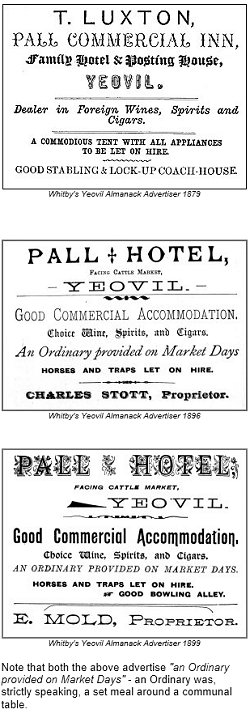 Robert Allen was
born about 1824
in Sherborne,
Dorset, the son
of painter
Richard Allen
and his wife,
Sarah. In the
1841 census
15-year old
Robert's
occupation was
given as a
painter's
apprentice and
ten years later,
still living at
home with his
parents and
eleven siblings,
he was listed as
a painter. By
the time of the
1861 census
Robert had
married Matilda
Catherine Buller,
had a son,
Robert junior,
had moved to
Yeovil and had
become licensee
of the
Greyhound
where the census
listed him as a
victualler with
Matilda, their
son and her
mother living on
the premises
along with three
servants (a
house servant,
an ostler and a
nurse maid) and
two lodgers. In
the 1871 census
the only
differences were
three additional
children and
only one servant
and Robert's
occupation was
listed as
innkeeper. By
1881 Robert and
his family had
moved around the
corner and were
living in
Union Street.
Robert's
occupation was
now the manager
of a soda water
manufactory, and
still was ten
years later.
(The Mineral &
Soda Water Works
were located in
Union Street,
opposite what
used to be the
front entrance
to the police
station)
although in 1889
he was listed in
Kelly's
Directory as the
licensee of the
Pall Hotel.
Robert died in
September 1900.
Robert Allen was
born about 1824
in Sherborne,
Dorset, the son
of painter
Richard Allen
and his wife,
Sarah. In the
1841 census
15-year old
Robert's
occupation was
given as a
painter's
apprentice and
ten years later,
still living at
home with his
parents and
eleven siblings,
he was listed as
a painter. By
the time of the
1861 census
Robert had
married Matilda
Catherine Buller,
had a son,
Robert junior,
had moved to
Yeovil and had
become licensee
of the
Greyhound
where the census
listed him as a
victualler with
Matilda, their
son and her
mother living on
the premises
along with three
servants (a
house servant,
an ostler and a
nurse maid) and
two lodgers. In
the 1871 census
the only
differences were
three additional
children and
only one servant
and Robert's
occupation was
listed as
innkeeper. By
1881 Robert and
his family had
moved around the
corner and were
living in
Union Street.
Robert's
occupation was
now the manager
of a soda water
manufactory, and
still was ten
years later.
(The Mineral &
Soda Water Works
were located in
Union Street,
opposite what
used to be the
front entrance
to the police
station)
although in 1889
he was listed in
Kelly's
Directory as the
licensee of the
Pall Hotel.
Robert died in
September 1900.
Edwin Mold was born about 1844 at Fisherton, near Salisbury, Wiltshire, the son of a journeyman sawyer, Thomas Mould, and his wife Elizabeth. In the 1851 census Edwin was living in Back Lane, Fisherton with his parents and seven siblings but by 1871 Edwin was employed as a porter in the City Hotel, Bristol, where he was one of 29 live-in employees! By 1881 he had married and was living in Wellington Street, Yeovil with his wife, Eliza, two sons and a daughter. He was employed as a hotel boots. In the 1891 census Edwin was listed as a publican at the Pall Hotel and advertised himself in Whitby's Yeovil Almanack Advertiser of 1901 as "late Boots of the Choughs Hotel". He and Eliza lived in the Pall with four of their children. Edwin was listed as the licensee of the Pall in Kelly's 1895 Directory and in the same year the Western Gazette Almanac listed HW Pearce as the proprietor of the Pall Hotel and the following year Whitby's listed Charles Stott as proprietor. Edwin died in 1895 (possibly in Honiton, Devon) and Eliza was listed as licensee of the Pall Hotel from 1897 until 1903. She died in 1929 aged about 85.
Ellen Davies was
born about 1854
in Yeovil and
was listed in
the 1907 Yeovil
Directory as the
new licensee of
the Pall Hotel.
In the 1911
census she was a
57-year old
widow and had
had nine
children, three
of whom had
died. She had
been married at
least twice
because living
with her at the
Pall were her
two unmarried
sons, Charles
aged 36 and
William aged 34,
who both had the
surname Powell
and were both
born in
Monmouthshire,
Wales. Her two
daughters, Gwen
aged 22 and
Elizabeth aged
21, were also
born in
Monmouthshire.
Both daughter
were unmarried
and both had the
surname Davies,
indicating they
were from
Ellen's second
marriage. Ellen
was frequently
listed in
various trade
directories up
until 1919 after
which Elizabeth
assumed the
license of the
Pall until at
least 1939.
Ellen died in
Yeovil in
December 1927
aged about 73.
MAP
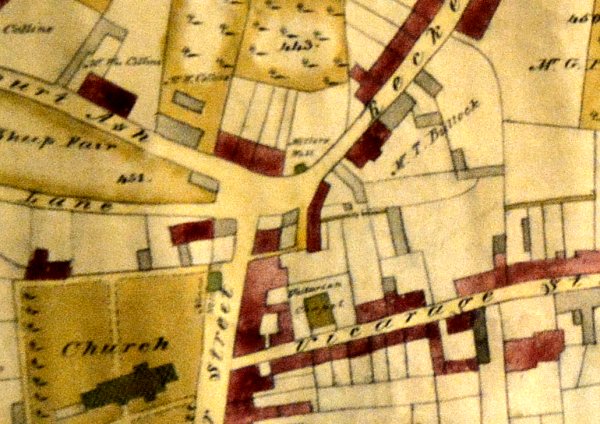
E Watt's map of Yeovil of 1806 showing the junction of Sheep Lane / Court Ash / Reckleford / Silver Street (today's North Lane / Court Ash / Market Street / Silver Street). At centre, is the original Pall Tavern (before it was rebuilt in 1836) with a narrow alley running alongside leading to the original Woborn Almshouse that also faces Miller's Well at its northern end.
gallery
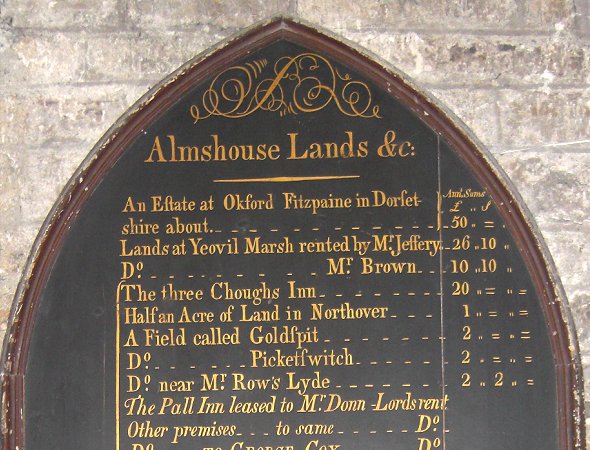
One of the four Charity Boards on the wall of St John's bell tower. Listing all the lands the Woborn Almshouse owned in 1804, including the "Pall Inn leased to Mr Donn".
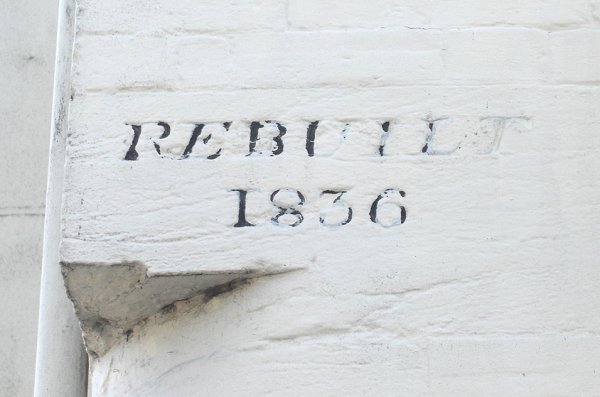
At high level on the corner of the Pall building this partly painted-out notice gives the date of the rebuild. Obviously no photographs exist of the first Pall building seen in the 1806 map above.
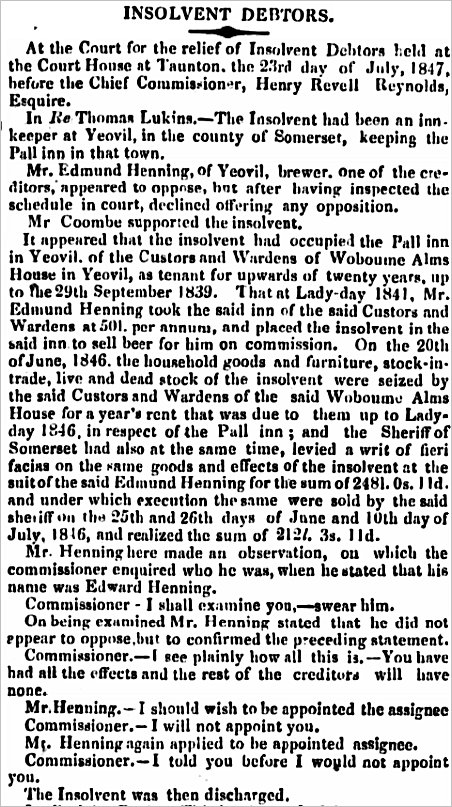
The report on the insolvency of Thomas Lukins and the involvement of Edmund Henning in the running of the Pall, from the 28 July 1847 edition of the Taunton Courier.
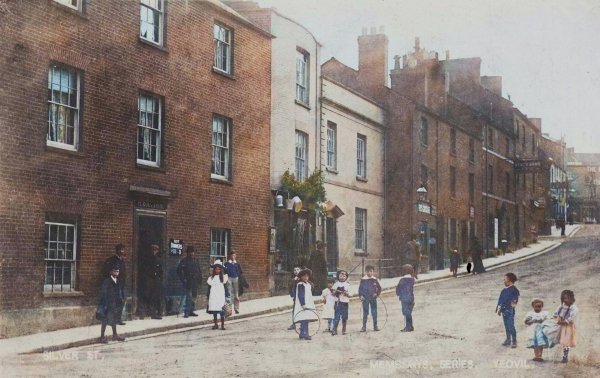
This
colourised
postcard
features in my
book 'Yeovil
- The Postcard
Collection'.
This postcard dates to around 1900. Henry Little's gun shop cum ironmongery was the three-storey, single-bay bow fronted building adorned with buckets and other ironmongery paraphernalia, next to the Pall Tavern (in naked brickwork!).
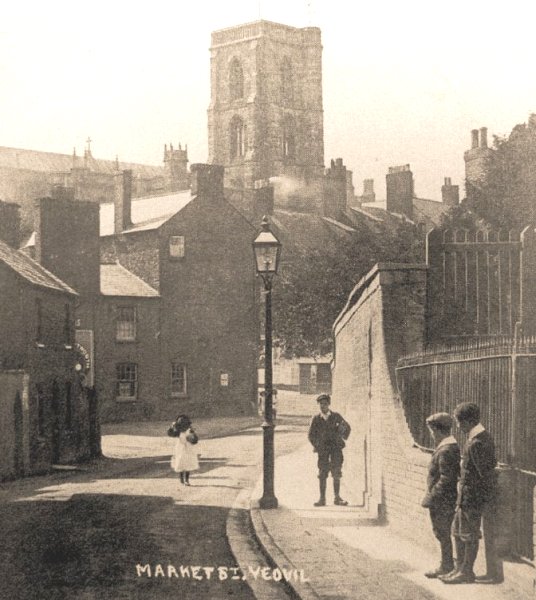
A sepia-toned photograph dating to 1905 looking along Market Street towards the Pall Inn, to the left of the streetlight, dominated by the tower of St John's church.
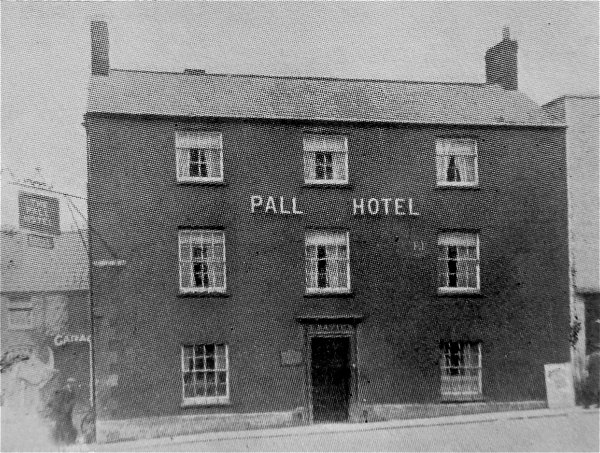
From my
collection
The Silver Street elevation of the Pall in a photograph taken in the early 1930s.
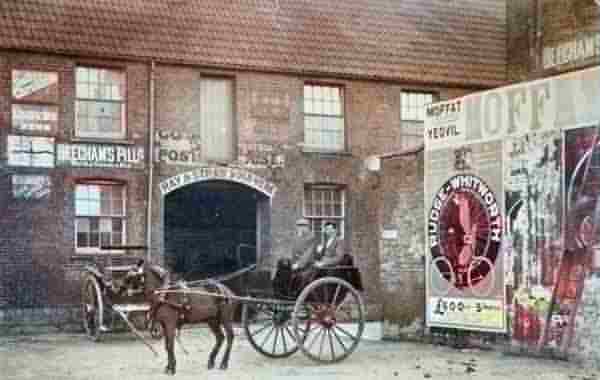
From my
collection
The Pall Tavern's yard, in a colourised photograph taken in 1908. The side wall of the Pall itself is at extreme right with 'Beecham' written on it at high level. The main building of this photograph is now an Indian restaurant.
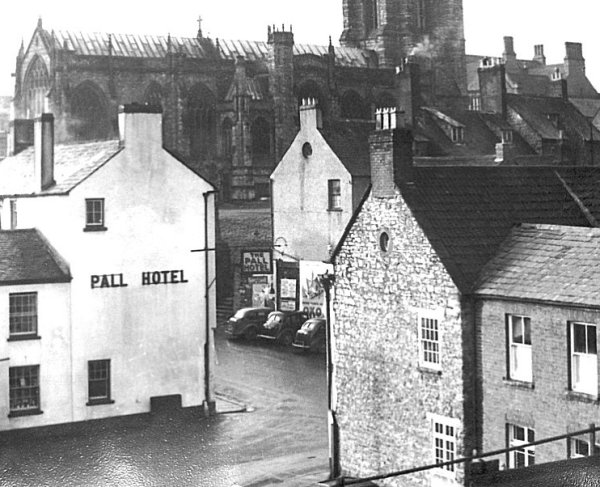
The Pall Hotel seen from the north and photographed during the 1950's. Note that the end wall is plain and lacks the three-storey fire escape extension as seen in the last photographs here.
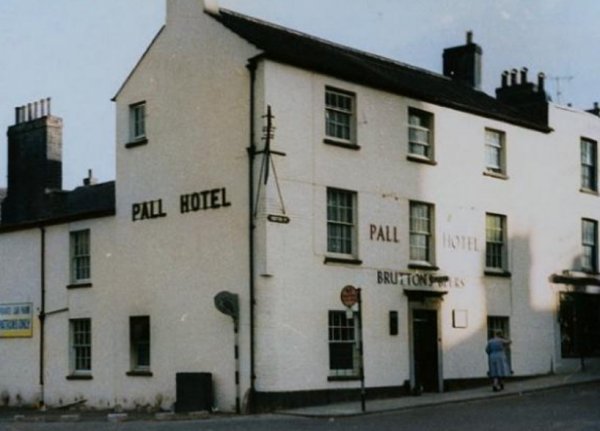
A colourised photograph of 1960 by Charrington & Co Ltd's surveyors as part of a 'stocktaking' exercise of photographing Brutton's pubs prior to the brewery takeover.
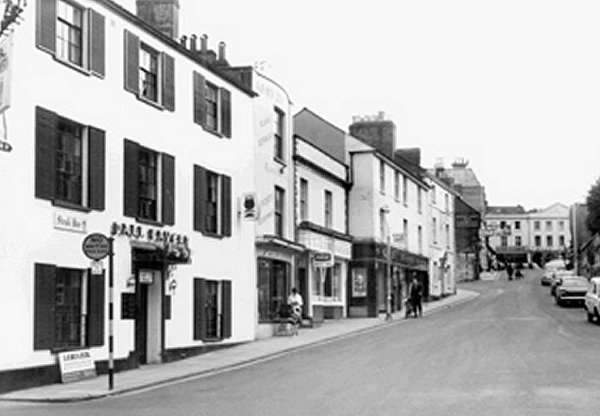
So, there's the Pall Tavern and the run of shops up to the King's Arms (the last white building) in this photograph from the 1960's. Now imagine the whole lot moved some six feet or more into the road while opposite, where the cars are, is a row of small houses - you've now got some idea of how narrow Silver Street was in the 1830's. What's more, the photographer would probably have been knee deep in the Rackle stream.
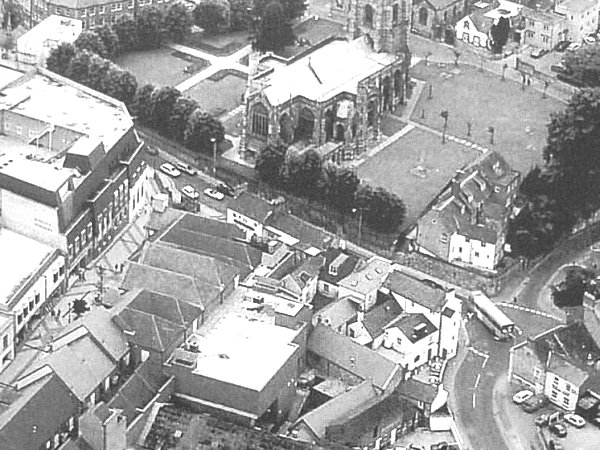
In an aerial photograph of 1988 dominated by St John's church at the top and new Quedam Centre shops at left, the Pall Inn is towards the lower right with the bus passing it. Also visible is the rear of the Kings Arms 3, just to lower right of the three white cars by the church.
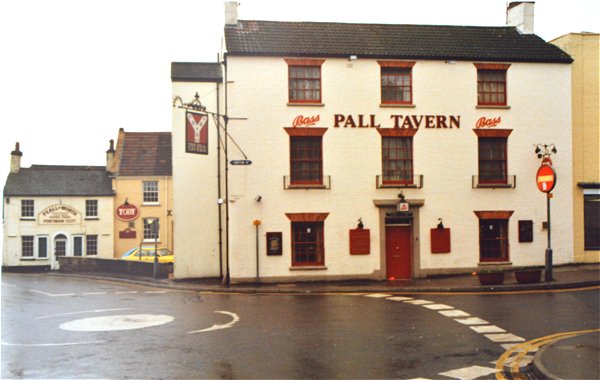
Courtesy of
Chris Rendell
The Pall Tavern photographed in 1989.
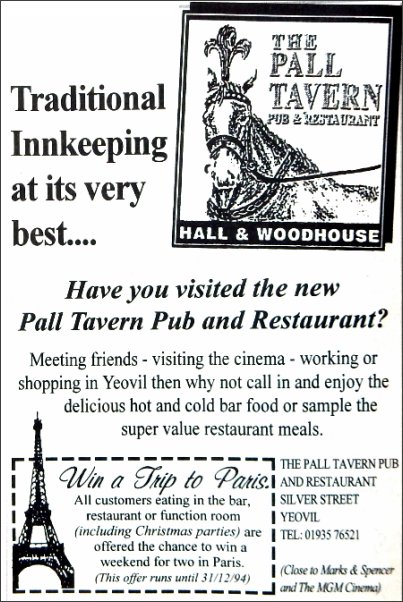
From my
collection
Advertisement for the Pall Tavern from the Visitor, November 1994.
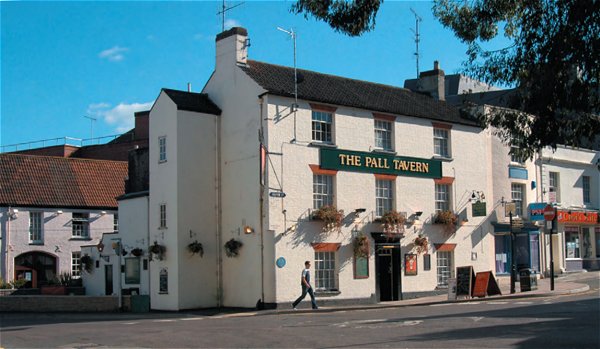
This photograph
features in my
book "A-Z
of Yeovil"
The Pall Tavern, photographed in 2005.
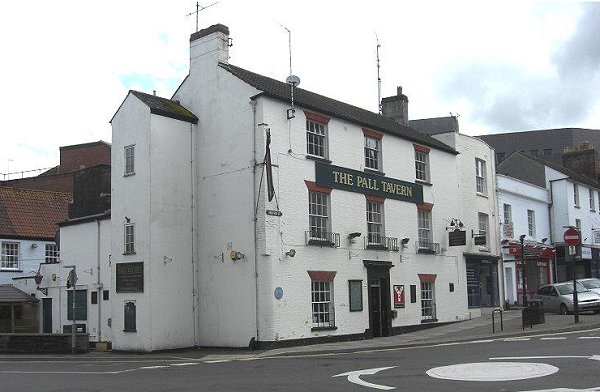
The Pall Tavern in 2012. The site of the Horse Pool was to the side of the Pall, where the small wall at the very left of the photograph now stands.
licensees - Owners
As a private dwelling
1587 - Thomas
Downton (Woborn
Muniments)
1606 - John
Allen, curryer
(Woborn
Muniments)
1632 - Henry
Trent
(Woborn
Muniments)
1651 - Maria
Swetman
(Woborn
Muniments)
1667 - William
Ashford,
husbandman
(Woborn
Muniments)
1690 - Jone
Ashford, widow
(Woborn
Muniments)
1716-47 -
William Hammond
(Woborn
Muniments)
1751 - Widow
Hammond
(Woborn
Muniments)
As the Pall Inn
1769 - Henry
Donn 'at the
sign of the
Paul, in ruinous
condition'
(Woborn
Muniments)
1769 – Henry
Donn – John Dix,
tenant (Lease -
see below)
1782-86 - Wm.
Eglen (Notes of
LC Hayward)
1796 – Mrs
Kitson (Woborn
Almshouse
Account Book)
1805 - Kitson
(Woborn
Muniments)
1816 - Mr Kitson
(Notes of LC
Hayward)
1822 – Job Brown
(Pigot’s 1822
Directory)
listed as Pall
1824 – Job Brown
(Pigot's 1824
Directory)
1827 - J Lukins
(Q. Sess. Dep)
1828 – Yeovil
Almshouse, owner
- Thomas Lukins,
occupier (Land
Tax Returns)
incorrectly
listed as the
Bell
1830 – Thomas
Lukins (Pigot’s
1830 Directory)
listed as Pall
1831 – Yeovil
Almshouse, owner
- Thomas Lukins,
occupier (Land
Tax Returns)
1836 - Rebuilt, old material sold for £22.10s.
1839 – George
Harris (Robson’s
1839 Directory)
listed as the
Pall
1840 – George
Harris (1840
Somerset Gazette
Directory)
1841 – Thomas
Lukins –
Innkeeper (1841
census) pub not
named
1842 – Thomas
Lukins (Pigot’s
1842-4
Directory)
listed as Pall
1850 – Thomas
Lukins (Hunt &
Co's 1850
Directory)
1851 – Thomas
Lukins –
Innkeeper (1851
census) listed
as Pall Inn
1852 – Thomas
Lukins – Inn
Keeper (Slater’s
1852 Directory)
listed as Pall
1859 – Mrs
Lukins
(Harrison,
Harrod & Co 1859
Directory)
1861 – Sophia
Allen – Inn
Keeper (1861
census) listed
as Pall Inn
1871 – Francis
Harrold – Hotel
Keeper (1871
census) listed
as Pall Hotel
1875 – Thomas
Luxton (1875
Post Office
Directory)
listed as Pall
Hotel
1875 – Thomas
Luxton (Kelly's
1871 Directory -
Hotels & Inns)
1879 – T Luxton
(Whitby's 1879
Yeovil Almanack
Advertiser)
1881 – Robert
Leach – Hotel
Keeper (1881
census) listed
as Pall Hotel
1889 – Robert
Allen (Kelly’s
1889 Directory)
listed as Pall
Hotel
1891 – Edwin
Mold – Publican
(1891 census)
listed as Pall
Hotel
1894 – Edwin
Mold - License
transfer
(Borough Petty
Sessions,
November)
1894 – Herbert
Wyman Pearce -
License
transferred
(Borough Petty
Sessions,
November)
1895 – Edwin
Mold (Kelly’s
1895 Directory)
listed as Pall
Hotel
1895 – HW Pearce
– Proprietor
(Western Gazette
Almanac)
1896 – Charles
Stott –
Proprietor
(Whitby's Yeovil
Almanack
Advertiser)
1897 – Mrs Eliza
Mold (Kelly’s
1897 Directory)
listed as Pall
Hotel
1901 – Eliza
Mold (widow of
Edwin above) –
Publican (1901
census)
1901 – E Mold
(Whitby's 1901
Yeovil Almanack
Advertiser)
1903 – E Mold –
Proprietor
(Whitby's Yeovil
Almanack
Advertiser 1903)
1907 – Mrs Davis
(1907 Yeovil
Directory)
1908 – Ellen
Davies –
Proprietress
(Whitby's Yeovil
Almanack
Advertiser)
1911 – Ellen
Davies (57 year
old widow) –
Proprietress
(1911 census)
1911 – Mrs
Davies (1911
census Summary)
listed as Pall
Hotel
1914 – Ellen
Davies (Kelly’s
1914 Directory)
listed as Pall
Hotel
1914 – Ellen
Davies (late
mother) -
License transfer
(Borough Petty
Sessions, July)
1914 – Ellen
Davies
(daughter) -
License
transferred
(Borough Petty
Sessions, July)
1919 – Mrs Ellen
Davies (Kelly's
1919 Directory)
1923 – Miss
Elizabeth Davies
(Kelly’s 1923
Directory)
listed as Pall
Hotel
1936 – EE Davies
(1936 Yeovil
Directory)
listed as Pall
Hotel
1938 – EE Davies
(1938 Yeovil
Directory)
listed as Pall
Hotel
1939 – Miss
Elizabeth Davies
(Kelly’s 1939
Directory)
listed as Pall
Hotel
1947 – L Cousen
(1947 Yeovil
Directory)
listed as Pall
Hotel
1949 – LF
Cousins (Kelly’s
1949 Directory)
listed as Pall
Hotel
1951 – LFS
Cousins (1951
Yeovil
Directory)
listed as Pall
Hotel
1954 – CM Arnold
(1954 Yeovil
Directory)
listed as Pall
Hotel
1954 – Charles M
Arnold (Snell's
1954 Directory)
By 1957 Charles
was licensee of
the
Picketty Witch.
1957 – W Carter
(1957 Yeovil
Directory)
listed as Pall
Hotel
1960 – R Wills
(1960 Yeovil
Directory)
listed as Pall
Hotel
1965 – Ronald
James Wills (Foord's
1965 Directory)
1968 – Licensee
not named
(Kelly’s 1968
Directory)
listed as Pall
Hotel
1969 – Licensee
not named
(Kelly’s 1969
Directory)
listed as Pall
Hotel
1970 – Licensee
not named
(Kelly’s 1970
Directory)
listed as Pall
Hotel
1971 – Licensee
not named
(Kelly’s 1971
Directory)
listed as Pall
Hotel
1972 – Licensee
not named
(Kelly’s 1972
Directory)
listed as Pall
Hotel
1973 – Licensee
not named
(Kelly’s 1973
Directory)
listed as Pall
Hotel
1974 – Licensee
not named (1974
Yeovil
Directory)
listed as Pall
Hotel
documentation
|
|
Note - much of the early documentation concerns the building that was later to become the Pall Tavern, the Horse Pool, a building called the Dye House and the Woborn Almshouse - all seen in the sketch map at top of this page. The Horse Pool was to the immediate north of the Pall Tavern, the Dye House was immediately behind the Pall Tavern and the Woborn Almshouse was attached to the north of the Dye House and to the immediate east of the Horse Pool. |
|
1550 |
Lease at 16s. per annum, for 60 years - John Dyrdo, custos, John Hacker senior, John Clothyer, wardens, to Ambrose Gregory - burgage called the Dyehouse. fine . Witnesses, Richard Hacker (ppos.) John Phelpes, William Hayne, sen., John Locke, James Dyrdo, Thomas Erlyche, Stephen Trente, John Dyer. 20 January 3 Edw VI (Woborn Almshouse Muniments No. 110) |
|
1587 |
Lease at 6s. per annum for 41 years - John Hacker the elder, custos, Mathew Darby and John Langdon, wardens, to William Beacham, sack-weaver of Yeovil, house called the Dye house between the Almshouse on the east and the tenement belonging to the Almshouse (now lately held by Thomas Downton) on the west (the Pall). 30s. fine. 20 September 29 Elizabeth. (Woborn Almshouse Muniments No. 120) |
|
1606 |
Lease for 60 years at annual rent of 10s. - Mathew Hacker, custos, Frauncis Sutton, John Crocker, wardens, to John Allan of Yevell, curryer, messuage (the Pall building) between the horse poole on north and tenement of Thomas Gregory on south and house of William Beachman (Dye House) on east, and place adjoining to dress leather. fine 6s.8d. Witnesses Frauncis Sutton, John Dyer. 10 May 1606. (Woborn Almshouse Muniments No. 2) |
|
1622 |
Lease for 3 lives at annual rent of 6s.8d. - Nicholas Patten, custos, Giles Jennynges, John Hardynge, wardens, to John Beacham of Yevell sackweaver, house called the Dye Howse between Almshouse on east and tenement (the Pall building) held by Henry Trent on west - Lives of John Beacham, Anstes his wife, and James their son. fine 6s.8d. Witnesses Geo. Hacker, Wm. Criendfield, Henry Trent, Henry Whedon - 1 April 1622. (Woborn Almshouse Muniments No. 12) |
|
1649 |
Lease for 2 lives at annual rent of 6s. - John Cary, custos, Richard Lockett, gent., Christopher Allambridge (the Younger), wardens, to Thomas Churchouse weaver of Yeovil, house called ther Dye House between Almshouse on east and tenement (the Pall building) belonging to the Almshouse held by William Swetman senior on west, lives of William Swetman and Elinor his wife. fine 25s. Witnesses - Morgan Hayne, John Withell, John Cary. 8 May 1649. (Woborn Almshouse Muniments No. 34) |
|
1651 |
Lease for 3 lives at annual rent of 10s. - Richard Roch, custos, George Winsor, John Grobham, wardens, to Marie Swetnam of Yeavell, spinster, tenement (the Pall building) between the Horsepool on north, and tenements of Joseph Swetnam on south, and house (Dye House) of Thomas Churchhouse on east now held by William Swetnam, father of Marie Swetnam, and half the house of office thereunto belonging, lives of Marie Swetnam, Stephen, brother to Marie, and Joseph, son of Joseph Swetnam, captain, aforesaid. Signed (mark of) Marie Swetnam. fine £12. Witnesses Theophilus Collins, William Daniell, (mark of) John Panfield, John Cary, Matthew Wills, Morgan Hayne, Richard Lockett. 20 May 1651 (Woborn Almshouse Muniments No. 38) |
|
1664 |
Lease for 2 lives at annual rent of 6s.8d. - Edward Burford, custos, Nathaniel Cary, Samuel Prowse, wardens, to Thomas Churchhouse, weaver, of Yeovil, house called the Dye House between the Almshouse on the east and tenement (the Pall building) of Almshouse now held by William Swetnam senior on the west - former lease of Thomas Churchhouse now surrendered - lives of Thomas Churchhouse and Mary his wife. fine £4. - Witnesses: Geroge Prowse, John Cary, William Swetnam, William C..?.., 14 June 16 Charles II. Endorsed; peaceable possession taken that day - George Prowse, William Cosby(?) (Woborn Almshouse Muniments No. 59) |
|
1667 |
Lease for 3 lives at annual rent of 6s.8d. - Gyles Hayne, custos, George Prowse, gent., Christopher Allambridge, gent., wardens to Thomas Churchouse, weaver of Yeovil, house called the Dye house between the almshouse on the east and tenement (the Pall building) of the same almshouse held by William Swetnam senior on the west - Lives of Thomas Churchouse, Elizabeth his wife, and Elianor their daughter. fine £4.10s. (mark of) Thomas Churchouse - Witnesses: John Cary, Matthew Wills senior, Matthew Wills junior. Endorsed; quiet and peaceable occupation taken - 16 May 1667 (Woborn Almshouse Muniments No. 63) |
|
1677 |
Lease for 3 lives at 10s. per annum - Ambrose Seward, custos, Nathaniel Cary, William Rowe, wardens to William Ashford, husbandman of Yeovil - tenement (the Pall building) between the Horse Pool on the north side and land of Joseph Swetnam on the south. fine £5. Lives of William Ashford, William and Gideon, sons. Signed Will Ashford; Witnesses Francis (?) Jacob, Lyonell Jervis, (mark of) Thomas Churchouse. 17 December 29 Charles II (Woborn Almshouse Muniments No. 66) |
|
1681 |
Lease for 3 lives at annual rent of 6s.8d. - Gyles Hayne, custos, Nathaniel Cary, gent., John Knight, mercer, To Robert Hodges, taylor of Overcompton, Dorset - surrender of lease Elizabeth Gaylard now wife of Bernard Gaylard, yeoman of Yeovil - dwelling house and garden called 'the Dye House' between the Almshouse on the east and tenement (the Pall building) of the Almshouse now held by William Ashford on the west. Lives of Robert Hodges, Elizabeth Gaylard and Hircules Hodges, son. Fine £5. Signed: Gyles Hayne, Nathaniel Cary, John Knight (no witnesses). 24 May 33 Chas II (Woborn Almshouse Muniments No. 68) |
|
1690 |
Lease for 3 lives at 10s. per annum - Richard Roch, custos, Nathaniel Cary, John Knight, wardens, to Jane Ashford, widdow and relict of William Ashford, yeoman deceased, (surrendering indenture) Burgage (the Pall building) between the Horse Pool on the north side and tenement of Joseph Swetnam on the south and a convenient roome or place in the curtilage next adjoining to do any necessary business and half the house of office thereunto belonging - Lives of Jane Ashford, Gideon and Jonathan Ashford, sons. Fine £8. Signed Johan Ashford, Witnesses George Prowse, Xpher Jeanes, John Newman. Endorsed; Jane Ashford's counterpart. 2 Wm & Mary. 10 February 1690 (Woborn Almshouse Muniments No. 76) |
|
1690 |
Lease for 99 years at an annual rent of 6s.8d. - Richard Roch, gent., custos, Nathaniel Cary, gent., John Knight, mercer, wardens, to Robert Hodges taylor, of Yeovill, - the Dye House between the Almshouse on the east and the tenement (the Pall building) belonging to the Almshouse now held by Mary Ashford, widow, on the west, and garden with house erected thereon now occupied by Robert Hodges his undertenants - Lives of Robert Hodges, Robert senior and Ruth, daughter. Fine £4.10s. - Signed Richard Roch, Nathaniel Cary, John Knight. Witnesses: George Prowse, Samuel Daniel, Jeremiah Hayne. 2 W&M 24 Nov 1690 (Woborn Almshouse Muniments No. 77) |
|
1769 |
Lease for 99 years at 10s. per annum - James Hooper, Esq., custos, Francis Crane Parsons, clerk, John Old Goodford, Esq., wardens - to Henry Donn, mercer of Yeovil. Fine £2.2s. and undertaking to repair messuage 'in very ruinous condition', with Horse Pool on north, now in tenancy of John Dix, known by the name and sign of the Paul - Lives of Henry Donn, Ann his daughter and John his son, of Edward B. gent., (sic) Signed Henry Donn - seal: head of mule. Stamp Duty 1s. Endorsed: Lord's rent 10s. - 27 October 1769 (Woborn Almshouse Muniments No. 92) |
|
1822 |
The Pall Inn was let to Henry Donn in 1769, for a term of 99 years, determinable on three lives, at the rent of 10s. in consideration of a fine of £2.2s. and of the lessees having repaired the premises, which are stated in the lease to have been in a very ruinous state... the premises are now valued at £20.... per annum. Henry Donn, the lessee, is the person that has been mentioned as having been custos of the almshouse for several successive years. As it is impossible, at this distance in time, to ascertain what repairs were done by the lessee, it is equally so to form a judgment upon the fairness of the transaction between him and the charity. (Charity Commissioners Report, 1822 - re Woborn's Almshouse) |
|
1830 |
28 September 1830 - Ordered that the Wale of the Horse Pond be set back, and raised so as to improve the town and prevent accidents. (Town Commissioners Minutes) |
|
1835 |
22
June
1835 -
It was
resolved
that the
Town
Commissioners
shall be
allowed
to throw
into the
Street a
part of
the
front of
The Pall
Inn
described
in a
Plan
prescribed
this day
by Mr
Joel
Hardy
measuring
34ft
10insin
length
from
North to
South &
2 feet
in width
at the
Southern
and not
less
than one
foot nor
more
than
fifteen
inches
at the
Northern
extremity
thereof.
And that
the
Master
of the
Almshouse
shall be
allowed
to take
into the
new
Building
about to
be
erected
at the
Pall Inn
such
part of
the
Horse
Pond as
they may
require
for
bringing
the said
new
Building
square
and that
The Town
Commissioners
shall
pay to
the
Master
of the
Almshouse
for such
land as
they may
take
over &
above
what
they may
give at
the rate
of 1s.
for each
foot
superficial
measure
this
arrangement
being
considered
mutually
beneficial
to each
Trust
and
particularly
to the
Almshouse. |
|
1836 |
2 May
1836 -
It was
resolved
that Mr
Hardy
shall
alter
the Plan
of the
Pall Inn
as to
leave
the
front to
range
with Mr
Duffett's
premises
and to
take
what is
necessary
from the
Horse
Pool
persuant
to a
Resolution
entered
into on
the 22nd
day of
June
last.
(Almshouse
Minute
Book ) |
|
1836 |
3 May
1836 -
It
appearing
to the
Commissioners
that the
ancient
watering
place in
Rackleford
adjoining
the Pall
Inn
commonly
called
the
Horse
Pond is
unnecessary
and that
same is
an
annoyance
to the
Inhabitants
of that
neighbourhood,
and that
it would
be a
material
improvement
to the
Town if
such
Pond
were
done
away
with -
It is
ordered
that the
same be
drained
and
filled
up - And
that in
lieu
thereof
a
sufficient
tank or
reservoir
be made
for
supplying
water in
case of
fire -
And also
a trough
for
watering
horses
with a
lip or
spout of
sufficient
height
to allow
the
placing
of a
bucket
or other
vessel
underneath,
or a
pump, or
both, as
hereafter
may be
thought
most
advisable
for
furnishing
the
Inhabitants
with
Water. |
|
1837 |
Victoria day coach three times a week from Pall Inn to Salisbury - a seven hour journey. |
|
1856 |
Public Conveyances from the Pall Inn - Knighton's Waggon - Mondays, Wednesdays, Fridays, to Castle Cary, Bruton, Wincanton. Forcey's Van - Tuesdays to Crewkewrne and Chard. (Daniel Vickery - Sketch of Yeovil, p60) |
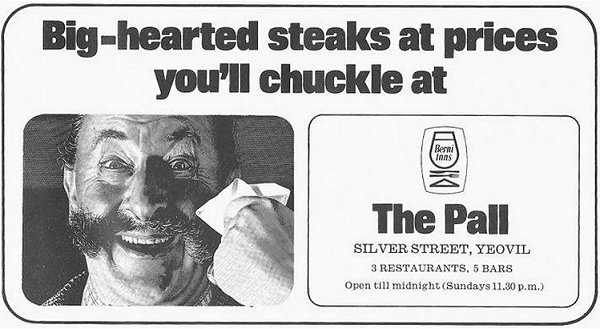
From my
collection
An ad from the 1970 Yeovil Official Guide Book. Aaaah... who remembers the Pall when it was a Berni Inn? with three restaurants and five bars - those were the days, we used to eat here very frequently.